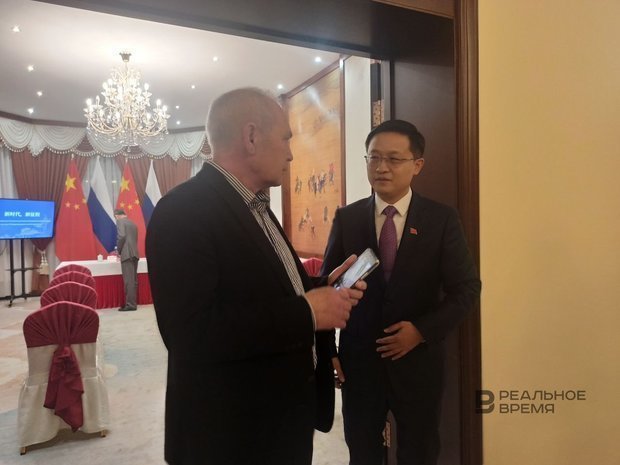Marina Reshetnikova, RUDN University: trade with China turns Russia into a raw material appendage of ‘World Factory’
“It was the technological assistance of the USSR that formed the basis for the formation of the PRC industry”
Thanks to the support of the USSR in the post-war period, China turned from a lagging agrarian state into a powerful industrial, scientific and technological giant. Marina Reshetnikova, an expert on China, Candidate of Economic Sciences, Associate Professor of the Department of Economics of the Peoples' Friendship University of Russia (RUDN), told Realnoe Vremya about this.
“The meme 'Russians and Chinese are iron brothers forever', very popular in the middle of the last century, had not only a political connotation. “It was the technological assistance of the USSR that formed the basis for the formation of the PRC industry. Strategically, this assistance consisted in creating a modern scientific and technological innovation complex for that time, allowing its further reproduction to be carried out on its own basis," she says.
This policy led to that many industries were created in China almost from scratch: defence, electrical engineering, chemical, light ones. Enterprises were established in the field of shipbuilding and mechanical engineering, metallurgy, and pharmaceuticals.
156 industrial facilities were built on the territory of China. Besides, the USSR transferred more than 1,400 projects of industrial enterprises and over 24,000 sets of scientific and technical documentation on a gratuitous basis. Also, 400 research institutes were created in China that were engaged in cloning samples provided from the USSR.
“The system of scientific process organisation, which the whole scientific world admired, was completely copied from the Soviet one. The result of these efforts was a rapid growth in the volume of trade between China and the USSR, which by 1959 had amounted to $2,1 million," says Marina Reshetnikova.
“The political short-sightedness of politicians of both countries practically nullified technological interaction”
Nevertheless, such close cooperation did not last long, the expert says. And because of the political differences between the leaders of the USSR and the PRC, technological cooperation practically came to naught.
“Unfortunately, such close cooperation did not last long. The political short-sightedness of politicians of both countries practically nullified technological interaction," Marina Reshetnikove concludes.
At the same time, it was the USSR that laid the foundation for the innovative development of Chinese industry, the penchant for copying. However, other countries took advantage of it, the expert notes.

“Innovative leaders skillfully used the skills invested by the USSR, turning the most powerful labour market into a global factory for copying modern high-tech products. In fairness, it should be noted that with varying success over the past 20 years, China has been trying to get out of this 'copying' circle," says Reshetnikova.
“Russia exports raw materials, importing everything from China”
Now Russia, the successor of the USSR, is increasingly slipping into the position of a raw material appendage of China, the expert notes. It supplies resources to the Celestial Empire, and everything is imported into our country: from feminine hygiene items and children's toys to high-tech goods — from smartphones to cars.
“Unfortunately, as sad as it sounds, we are increasingly slipping into the raw nature of interaction. Russia exports raw materials, importing everything from China, from feminine hygiene items and children's toys to high-tech goods, from smartphones to cars," says Marina Reshetnikova.
At the same time, the expert notes, cooperation between the innovative sectors of Russia and China continues to be more formal than real and productive. Nevertheless, the contacts of individual Russian universities with educational centres in China look encouraging.
“The leader here, of course, is the Tomsk Polytechnic University, whose cooperation in the development of non-destructive testing and safety with universities and scientific and technological companies of China has lasted for more than a decade. The result of this interaction can be the Russian-Chinese laboratory of radiation control and inspection operating on the territory of the university innovation centre," adds Marina Reshetnikova.
As part of this cooperation, the Tomsk Polytechnic University plans to open a mirror laboratory in China. The university has already signed a cooperation agreement with Powerscan Hitech, on the basis of which the research centre will be located.
“The laboratory will continue to develop and manufacture hardware and software for betatronic and digital radiography and tomography systems, as well as practical training of students, postgraduates and specialists in these fields. The main focus is on developments for X-ray systems based on betatrons. And betatrons are the smallest cyclic particle accelerators, this is a proprietary development of the Tomsk polytechnics," the expert clarifies.
However, the Tomsk Polytechnic University is not the only one developing cooperation with China. For example, this September, the Kazan Kazan Innovation University (CIU) sent students and teachers to China for an annual internship. They will spend 11 months in China to improve their language skills and get acquainted with the local culture, and they will return to Russia only in July next year.

At the same time, the new Consul General of the People's Republic of China in Tatarstan said at a recent meeting that four enterprises with the participation of Chinese capital were located in the republic with the assistance of the Chinese company Haier. Five more became residents of the Haier Industrial Park.
“I am sure that with the deepening of the development of Sino-Russian relations <...> more and more Chinese companies and enterprises, such as Haier, will come to Russia to invest and develop cooperation with Tatarstan," he noted.
“When carefully considering the reasons for the growth of trade, there are more reasons for concern than for joy”
Now Russia and China are increasing and strengthening trade cooperation. Marina Reshetnikova concludes that the increase in sanctions pressure on Russia after the start of the special military operation will lead to that it is China that will become Russia's main trading partner.
“The increased sanctions pressure on the Russian economy in connection with the start of its own has led to that in the near future China may become Russia's main trading partner," she concludes.
For example, at the beginning of August this year, it was reported that the trade turnover between the two countries increased by 29% and exceeded $97,7 billion. In the first 7 months of 2022, exports from China to Russia increased by 5,2% to $36,3 billion. Imports of goods and services from Russia to China increased by almost 50%, to $61,45 billion.
Already in early November, it became known that by the end of January-October 2022, the trade turnover between Russia and China increased by 33% year-on-year and amounted to a record $153,938 billion. It was noted that exports from China to Russia increased by 12,8% in 10 months and amounted to about $59,596 billion. Imports of Russian goods and services has increased by 49,9% to $94,342 billion.
“Yes, such growth is certainly good news. But is everything so rosy? When carefully considering the reasons for the growth of trade, there are more reasons for concern than for joy," Reshetnikova claims.

Firstly, the expert notes, the desired volume of trade between Russia and China is $200 billion. And this, according to her estimates, is unlikely to be achieved by the end of 2022. Besides, the main article in this trade is exports from Russia to China.
“It (imports to China — editor's note) has grown almost one and a half times and approached $94 billion. Exports in the opposite direction from China to Russia amount to a very modest $60 billion with a significantly small increase of 12,8%," says Marina Reshetnikova.
“The trade turnover has grown, but this growth boils down to that Russia supplies raw materials to the 'Great Factory' at a discount and buys finished products from it”
The expert highlighted other problems in Russia's trade relations with China. First of all, they are connected with that the basis of Russian exports to China is occupied by goods that meet “the code 27 of the Foreign Economic Activity”. These are fuel, oil and products of their distillation. If in 2020 the share of this category of goods in Russian exports to China was 56%, then in 2021 it increased to 68%, and in 2022 to 71%.
Recall that now China and India are the main buyers of Russian oil. In the face of Western sanctions and attempts to impose a ceiling on fuel prices, it is these Asian countries that are becoming the beneficiaries of the current situation. The expert of Rosneft, geologist Viktor Rusinovich, told Realnoe Vremya about this.
The second in the list, with a share of 5%, in Russian exports are ores and wood. The next are the Russian “high-tech” from “the code 84 of VEB” — “mechanical devices”, the expert notes with joy. Unfortunately, they occupy only 2% of Russian supplies. They are followed by, again, copper, ferrous metals and rolled metal.
“Yes, the trade turnover has grown, but this growth boils down to that Russia supplies raw materials to the 'Great Factory' at a discount and buys finished products from it. And this situation looks extremely alarming. If this trend takes hold, then Russia will finally slip into the mission of a raw material appendage to the “world factory," the expert concludes.
As for imports to Russia from China, 26% are accounted for by electric machines and equipment. Another quarter is occupied by goods from the same "84 VEB code”. The remaining half is “blurred” between ground transport, optical instruments, clothing, shoes and plastics.
In particular, experts predict a further increase in the number of sales of Chinese cars on the Russian market. In the first three quarters of this year, the Chinese cars took a share of 14,26% in the total number of car sales, 66,953 units of transport were sold. So far, according to this indicator, they lag behind the same Korean foreign cars, which accounted for 22,84% of the total number of car sales. During this period, 107,212 Korean foreign cars were sold in Russia. The leader, of course, are cars of domestic production.
“China's promises to increase scientific and technical cooperation with Russia remain in the intention phase. And our Ministry of Trade proudly reports an increase of 5% in plywood exports to China," says Marina Reshetnikova.